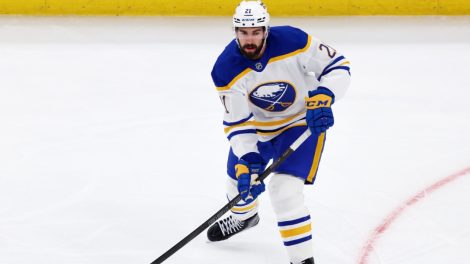MONTREAL— Jeff Gorton and Kent Hughes are facing many difficult decisions as they prepare to rebuild the Montreal Canadiens, but what to do with Paul Byron isn’t one of them.
If it wasn’t clear they should keep Byron before it was announced he’d make his return from off-season hip surgery over the weekend, listening to the 32-year-old finally detail what he’s been through made it abundantly so.
This is a player who has continuously proven he’ll never give up, and his story—of being claimed on waivers from the Calgary Flames and turning into a 20-goal scorer and an alternate captain with the Canadiens—has only become more inspiring with every chapter he’s written.
The young players in the organization should be reading with interest.
[snippet id=5216510]
“He’s a leader,” said co-alternate captain Brendan Gallagher on Saturday. “He was missed for sure. He’s someone that, first and foremost, I think a lot of players can look at what he’s gone through in his career, the attitude he’s had. He was not far away from being out of the NHL, and now he’s in a situation where he’s a 20-goal scorer in the NHL and a very relied upon kind of player that you know what you’re going to get from him every single night. Didn’t come from fluke; he had to prove a lot of people right along the way; he didn’t get the breaks, didn’t get the chances that a lot of players get, and he just stuck with it and stuck with it and had enough people to believe in him and give them that opportunity. He took advantage of it. I think when players come up and maybe they’re looking at their own situation and feeling a little bit sorry for themselves, it’s pretty easy to find inspiration when you look at Paul and what he means to our group in the locker room and just the energy and consistency he gives us night in, night out. He’s a very important player.”
Byron’s a player who loves the game and the team he plays it for. In an Instagram post released before he went under the knife, the feisty winger expressed just how much.
But in that same post, Byron also mentioned experiencing the toughest year and a half of his life.
We knew it was particularly challenging last season, with the pandemic in full swing, the cap-strapped Canadiens yo-yoing him on and off waivers, and with his performance dipping below the standard we’ve become accustomed to. But we didn’t know to what extent the Ottawa native was suffering.
That changed when Byron spoke for the first time this season on Saturday.
“Every day was different, every game was different,” he said. “I remember some days just taking off your equipment and barely being able to walk to your stall. Going upstairs was always tough some days. Not even being able to sleep after games. (The hip) would feel okay, and then you’d go to bed and every time you moved in your sleep it would wake you up in pain because all that adrenaline and Tylenol and Advil kind of wears off in the night. You’d wake up in the morning and you’d be pretty sore, you didn’t really sleep well and no recovery. It’s been a few years that this has been going on, and every year it’s just gotten worse.”
From the outside looking in, it was impossible to glean. It was obvious he wasn’t at 100 per cent, and we knew he’d been playing through bumps and bruises throughout the last couple of seasons, but he never let on as to how bad things had gotten. Byron showed up every day and practised as hard as anyone. He never once used injuries as an excuse for his performance, he never once complained about being cast aside due to cap constraints, and he continued to play every shift the way he always had—at full speed.
He just wasn’t moving as fast as he always had.
Byron’s hip had gotten so bad it had become debilitating. So he took a cortisone injection prior to last year’s playoffs thinking things couldn’t get worse.
The decision, made just days before scoring his iconic Game 1 winner against the Toronto Maple Leafs, probably saved Byron’s career.
“That was kind of the moment where the lightbulb went off in the head where I said, ‘Okay, it’s time to get it fixed,’” Byron said, “because that first week, those two weeks after, I felt incredible. I felt amazing.
“The injection didn’t last very long. A couple of games of the series, I was right back to where I was. But first few games to finish the year and start playoffs, it felt really good. It felt like I had my skating legs back. By Game 5, it was just right back to where it was and I remember saying in my head, ‘This could be your last game of the year; you’ve just gotta grind through it, push through it, give everything you have, you have literally nothing left to leave on the table and win the game’ Same thing Game 6, same thing Game 7, and that mentality just carried on. The more the adrenaline kinda hit, the more you got into playoffs, it was like the pain and everything just started to disappear. The focus was so heavy on the playoffs and on the play that nothing else mattered in the moment.”
When the Canadiens lost in Game 5 of the Stanley Cup Final to the Tampa Bay Lightning, Byron wasn’t just left with emotional pain.
For more than two years, he had been playing with a torn labrum and femoroacetabular impingement—a condition in which extra bone grows along one or both the bones that form the hip joint. It’s a condition where the bones rub against each other and cause chronic pain.
In Byron’s case, as he explained to Sportsnet following his media availability Saturday, the bone growth was “blocking the ball in the hip joint from moving and it was grinding the hip capsule where the labrum was torn.”
He underwent the procedure to shave down the bone growth and have his labrum fixed, and then Byron began what was supposed to be a five-month rehabilitation before he could return to play.
[snippet id=3816507]
Right as he was on the verge of coming back, on Dec. 29, Byron was placed in COVID-protocol due to an exposure to a close contact who contracted the illness. Days later, his time in protocol was extended considerably as he finally came down with COVID-19.
With the Canadiens deep into a seven-game road trip through January, Byron came out of protocol and had to wait for their return to Montreal so he could get back into practices and then make his long-anticipated season debut.
Watching the team crumble in his absence only made it that much more agonizing.
“It’s been hard watching a lot of games,” Byron said. “You’re on the sidelines, you know you can help out, you want to be with your teammates. Even when you lose the games you want to be with them, you want to be a part of it. Everything we’ve done is together, it’s a group, a bit of a family in here, so to be on the sidelines is not a good feeling inside.”
On Sunday, Byron stepped off of the sidelines in what turned out to be a 6-3 loss for the Canadiens to the Columbus Blue Jackets. He played 25 shifts and gave it everything he had on every single one of them, finishing the game with one shot attempt, three hits and some reassurances he can get back to the speedy player he was before suffering this terrible injury.
That was great news for him, but it should also have been encouraging news for Gorton and Hughes. Because if it wasn’t clear before, it should be now—it’s players like Byron who will help them establish the culture they should want for their team moving forward.
[relatedlinks]









